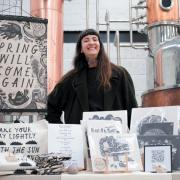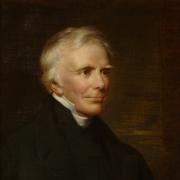This month marks 400 years since the iconic Mayflower docked in Southampton with its pilgrim passengers hopeful for a new life in America, but it wasn’t all plain sailing.

It was a July day in Southampton, 1620. A crowd gathered to stare as a commotion broke out on West Quay. Raised voices were heard and insults bandied.
These were not traders disputing a dockside deal or drunken stevedores spilling out the taverns spoiling for a fight. No, these were otherwise respectable types who had only recently sailed into port on two ships and moored without fuss by the quay.
One, little more than a 60-ton pinnace was the Speedwell. Older dock hands might have remembered her when she was called the Swiftsure and had seen action against the Spanish Armada more than 30 years before.
The other, much bigger at 180 tons, was a run of the mill vessel normally used in the cross-Channel wine trade. Its name, the Mayflower. Hardly worth a glance.

But what must have caught the eye of the dockers was that both ships were loaded, not with barrels of wine or serge, for which Southampton was noted, but men, women and children - entire families with their servants in tow.
It transpired that the two ships were planning to sail to Virginia, as the English colony in America was known, where they were to create a new settlement. The Speedwell had sailed from Holland with 67 members of a religious group who had lived in Leiden for ten years after fleeing persecution in England. Pilgrims, they dubbed themselves.
The 65 passengers on the Mayflower who had set off from the London port of Rotherhithe were altogether different; while the families from Leiden dreamed of creating a perfect society in a brave new world, the eager young adventurers on the Mayflower had more a material ambition; to make a fortune from the beaver trade.
Despite their mismatched aims the first meeting of these two groups in late July was amicable. William Bradford, who was to become governor of the settlement, wrote about a ‘joyful welcome and mutual congratulations with other friendly entertainment’, but the positive mood did not last long.

In fact, so bitter were the rows which broke out between the pilgrims and the London businessmen who were financing the voyages, known as the Merchant Adventurers, that the venture itself was threatened.
It had already got off to a bad start. The Speedwell sprung a leak on the short crossing from Holland and had to be repaired. Some chroniclers claim the ship had been fitted with masts and sails which were too big and strained the timber framework; Bradford blamed the ‘cunning and deceit of the captain and the sailors,’ who were reluctant to make the arduous voyage and sabotaged the venture.
While they waited for the repairs to be completed, the Leiden contingent started fighting among themselves. One accused another of spending £700 (ca £210,000 today) in Southampton on provisions such as cheese, bread and beer which had not materialised and, in return, was damned for his negligence.
What angered the pilgrim hierarchy most, however, was the way their negotiator with the Merchants; a gentle soul by name of Robert Cushman, had allowed himself to be bullied into accepting changes in the arrangements which had already been agreed. They demanded a bigger share of the profits and refused to let the pilgrims have two days off a week for prayer and rest. Or else, they threatened, they would pull out of the deal altogether.
Cushman was dubbed ‘brainless’ by his fellow pilgrims and accused of betrayal, while he in turn bitterly reproved them for behaving with ‘clamour and jangling’ and failing to sympathise with his impossible situation.
When it came to dealing face to face with the man representing those ‘bloodsuckers,’ as the pilgrims angrily described the Merchant Adventurers, they were as unsuccessful as Cushman. They could not make him relent ‘one jot.’ Thomas Weston was his name, a sly knave if ever there was, who warned them that one investor had already withdrawn his £500 investment (ca £150,000) and that others would follow suit if they did not agree to the new terms. They refused and he returned to London much offended leaving the pilgrims short of £100 (ca £30,000) to buy the last of their supplies.
They had little choice but to sell £60-worth of provisions, including three or four firkins of butter and, as Bradford wrote, ‘we put ourselves on the bare necessities.’
Quite possibly, as they squabbled, one of the passengers would have looked on with a patronising air for, as Stephen Hopkins was happy to boast, he was the only passenger to have crossed the Atlantic before.
Hampshire-born Hopkins was baptised in 1581 in All Saints church in Upper Clatford near Andover and later lived in Winchester and Hursley where he married his first wife Mary. In 1609 he took a job as a minister’s clerk and left his family behind to join an expedition to Jamestown, Virginia.
The ship was wrecked on Bermuda and after several months surviving on turtles, birds and wild pigs, Hopkins helped organise a mutiny against the expedition governor. It failed and he was sentenced to death.
Only craven pleas for mercy saved him. As an account had it: ‘So penitent he was, and made so much moan, alleging the ruin of his wife and children in this his trespass, as it wrought in the hearts of all the better sorts of the company’.
Eventually, the castaways built a boat and sailed to Jamestown where Hopkins stayed for several years before returning to live in Whitechapel, east London. The shipwreck captured the public imagination and some reckon it was the inspiration for Shakespeare’s play The Tempest. Hopkins, no doubt, rather fancied himself as the venerable seer Prospero, but he was more like his near namesake Stephano, the drunken butler.
Eager for another exploit he sailed from London on the Mayflower with his three children and second wife Elizabeth who was pregnant and gave birth during the voyage. They named the boy Oceanus.
A contradictory character, he took part in the early explorations on Cape Cod to find a suitable site for a settlement and served the new colony well, but he was often in trouble with the authorities. For example, he was fined £7 for assault and £2 for ‘suffering servants and others to sit drinking in his house and for selling beer, wine and ‘strong waters.’
He prospered, ending his days with 14 acres of land, a house and a ‘great bull’. But his legacy is not as significant as another man with a Southampton connection, albeit fleeting, 22-year-old John Alden. The crew had been recruited in London but there was a need for a cooper to maintain the barrels of beer and assist as a carpenter. Some historians have suggested Alden was born in Southampton, but it seems more likely he came from Harwich, Essex, hometown of the Mayflower skipper Christopher Jones, who invited him to join the enterprise.
Alden became one of the settlement’s leading lights, despite being caught up in the killing of a trespasser on settlement territory. He was held by the Massachusetts Bay Colony for questioning but discharged.
But perhaps his claim to fame is that he married fellow passenger Priscilla Mullins, whose parents and brother had all perished in the first winter, and together they had ten children who in turn are ancestors to two million Americans today.
He must have been mightily relieved when the ships set sail on August 5 ‘trusting to the good providence of God’ as Bradford recorded optimistically, only to have his hopes swiftly dashed when the Speedwell, still as ‘leakie as a sieve’ had to dock for more repairs, first in Dartmouth and again in Plymouth.
The Speedwell pulled out of the venture but, at last, on September 6, 1620, pilgrims and adventurers alike crowded on to the Mayflower and this time there was no turning back.



























